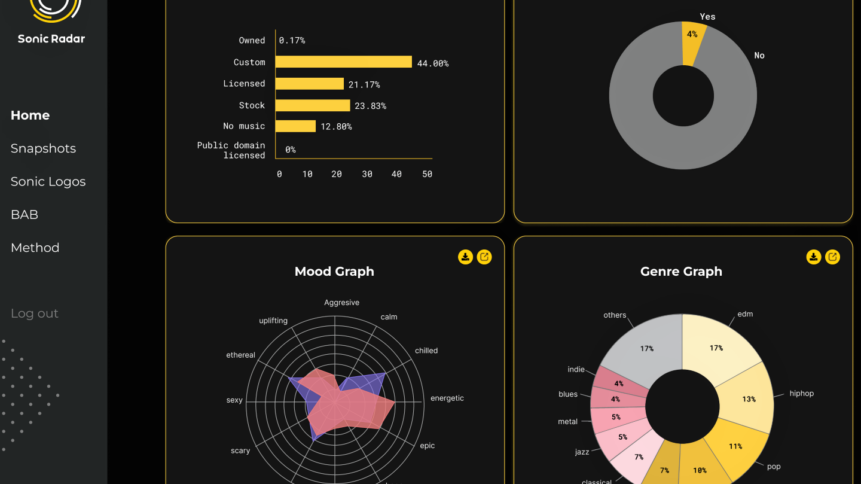
Voice control and hands-free operation have added a sonic dimension to modern electronic devices. We have become used to gadgets capable of generating audio alerts and prompts. And that presents both a challenge and an opportunity for device makers. How should a brand sound? What’s more, if we add social media, podcasts, and other audio-rich channels into the discussion, sonic branding suddenly becomes a talking point for any firm, not just device makers.
For companies that have time and resources aplenty, sonic branding is something that they can take their time over. BMW famously worked with multiple Oscar and Grammy award-winning composer Hans Zimmer to create the sound for its electric vehicles. But not all firms will have this luxury. And they don’t need to. Thanks to the power of artificial intelligence (AI), clients have a number of time- and cost-saving tools at their disposal.
Sonic DNA
“We don’t create jingles, we create sonic DNA,” Michele Arnese – founder and Global CEO of Amp – told TechHQ. “It’s the sonic expression of a brand.” Arnese studied engineering at the University of Pisa, Italy, and has a background in information technology and AI. He also has a passion for music production and quickly recognized the capabilities that algorithms could bring, particularly in helping to quantify sonic branding.
The firm – which has offices in Germany, the US, Singapore, and China – has fed data gathered on 1000 leading brands into its ‘sonic radar’ tool, which uses AI to classify and cluster key properties based on human research. And this gives clients a headstart in the first step of their sonic branding journey – understanding the music that they currently use.
For example, the AI tool can report on whether the audio deployed is happy, romantic, ethereal, and many other mood types, as well as genres. A company may want its soundtrack to be uplifting, and data analysis can quickly pinpoint whether this is actually the case – relating back to the codified knowledge of music experts. Usefully, the tool also provides competitor breakdowns too, so firms can see how they compare in the audio space.
KPI matching
The next tool in the AI-powered chain is ‘Sonic check’ – software that can validate whether sonic branding assets are well-matched to KPI’s such as ‘customer recall’. The process also considers emotional engagement and how likable the content is perceived to be. “It adds objectivity,” explains Arnese. “And clients can use the data to back up their decisions.”
Having numbers to hand can dramatically speed things up for customers – as anyone who’s been involved in a branding exercise will testify. Also, the data provides transparency even when members of the original client team have moved on or switched roles.
When users are happy that their audio has the required features, or Sonic DNA, they are ready for the third element dubbed ‘Sonic space’. “It’s a repository where customers can easily find their music,” said Bjorn Thorleifsson – Head of Strategy & Research at Amp, and an expert in data. “And when they use it, they can be confident that the assets will be on brand.”
With key characteristics tagged, algorithms make it straightforward to switch from one genre to another – for example from Hip Hop to EDM – while preserving the sonic branding, such as those ‘uplifting’ qualities mentioned earlier. “AI is terrible when it comes to creating, but it is fantastic when it comes to editing,” adds Arnese.
Clients can provide the software with a few simple instructions such as the length and cue points – for example, whether the track needs a ‘drop’ or a ‘grand finale’ – and an edited version will be generated to suit. It gives companies a huge amount of flexibility, whether they are compiling a 10-second video for TikTok, a 30-second Instagram Reel or minutes long content for YouTube – all clips will share the same sonic branding qualities.
There’s also the capability to integrate synthetic voices. And Amp has collaborated with Aflorithmic – a tech firm with expertise in converting text into engaging audio clips – so that clients can easily add voice-overs to video content. Together, the AI toolchain puts a lot of production expertise into the hands of users, while keeping the process straightforward for customers.
More to come
The team has a fourth AI-based component in the works and will be saying more about those features at an upcoming event in London, UK. But our conversation didn’t stop there. Arnese and Thorleifsson had a few more tips for companies, especially on the topic of product sounds. “You can create functional sounds out of the branded asset,” Thorleifsson points out.
Amp has worked with neuroscientists to understand which audio characteristics appeal to users. Interestingly, more complex tones were associated with value, with simple sinusoidal sounds being perceived as cheap in the research findings. There’s no shortage of insights for device makers to tap into. And with voice-based features and audio alerts on the rise, sonic branding is a term not just for marketeers, but also for product developers to remember.










